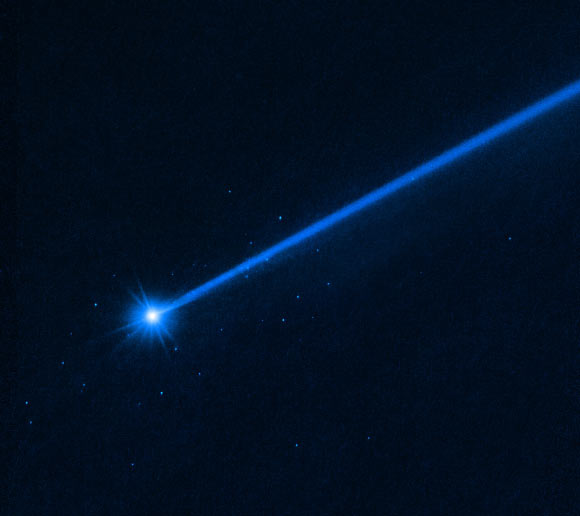On September 26, 2022, NASA’s Double Asteroid Redirection Test (DART) intentionally slammed into the 160-m-wide asteroid moonlet Dimorphos — which orbits the larger, 780-m-wide asteroid Didymos — for the first planetary defense test. Using the NASA/ESA Hubble Space Telescope, astronomers have now spotted 37 boulders that were possibly shaken off Dimorphos. The boulders range in size from 1 to 6.7 m (3-22 feet) across. Their total mass is about 0.1% the mass of Dimorphos. They are drifting away from the asteroid at little more than 0.8 kmh (0.5 mph).

This Hubble image of Dimorphos was taken on December 19, 2022, nearly four months after the asteroid was impacted by NASA’s DART mission. Dimorphos has a blue dust tail extending diagonally to the upper right. A cluster of blue dots surrounds the asteroid. These are boulders that were knocked off the asteroid. Image credit: NASA / ESA / D. Jewitt, UCLA.
“This is a spectacular observation — much better than I expected,” said Dr. David Jewitt, a planetary scientist at the University of California at Los Angeles.
“We see a cloud of boulders carrying mass and energy away from the impact target.”
“The numbers, sizes, and shapes of the boulders are consistent with them having been knocked off the surface of Dimorphos by the impact.”
“This tells us for the first time what happens when you hit an asteroid and see material coming out up to the largest sizes.”
“The boulders are some of the faintest things ever imaged inside our Solar System.”
The boulders are most likely not shattered pieces of the diminutive asteroid caused by the impact.
They were already scattered across the asteroid’s surface, as evident in the last close-up picture taken by DART just two seconds before collision, when it was only 11.2 km (7 miles) above the surface.
The impact shook off approximately 2% of the boulders on the surface of Dimorphos.
“The boulders could have been excavated from a circle of about 49 m (160 feet) across — the width of a football field — on the surface of Dimorphos,” Dr. Jewitt said.
Long ago, Dimorphos may have formed from material shed into space by the larger a Didymos.
The parent body may have spun up too quickly or could have lost material from a glancing collision with another object, among other scenarios.
The ejected material formed a ring that gravitationally coalesced to form Dimorphos.
This would make it a flying rubble pile of rocky debris loosely held together by a relatively weak pull of gravity.
Therefore, the interior is probably not solid, but has a structure more like a bunch of grapes.
It’s not clear how the boulders were lifted off the asteroid’s surface.
They could be part of an ejecta plume that was photographed by Hubble and other observatories.
Or a seismic wave from the impact may have rattled through the asteroid — like hitting a bell with a hammer — shaking lose the surface rubble.
“If we follow the boulders in future Hubble observations, then we may have enough data to pin down the boulders’ precise trajectories,” Dr. Jewitt said.
“And then we’ll see in which directions they were launched from the surface.”







